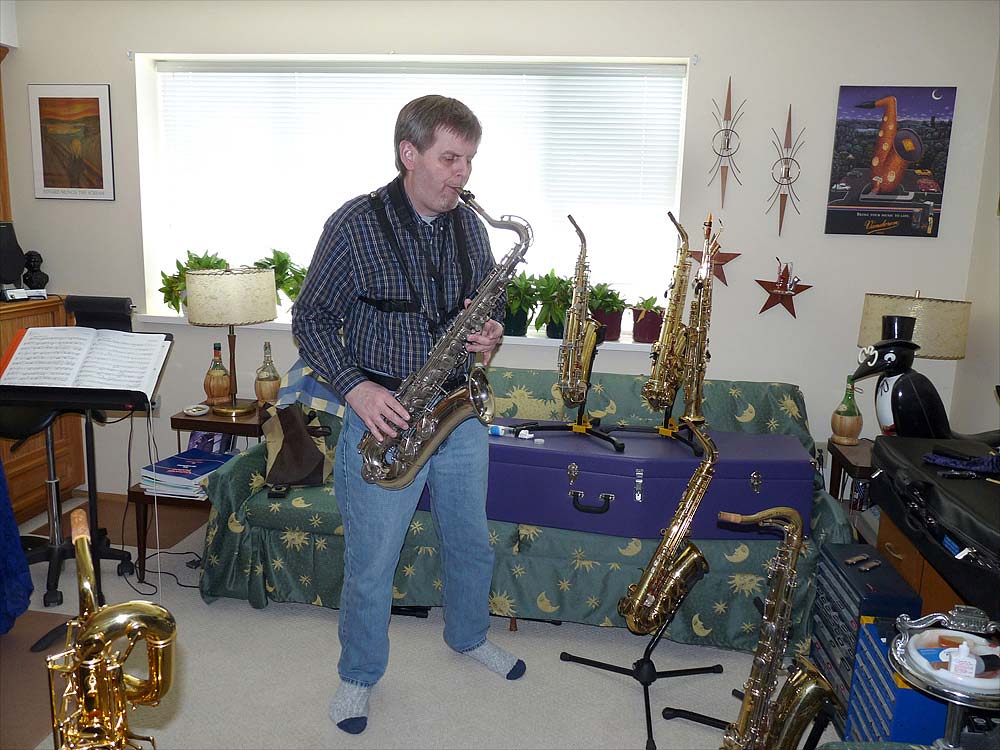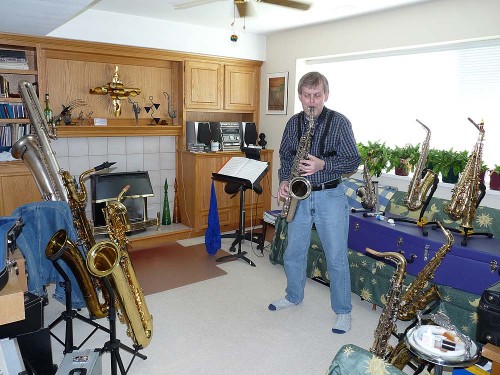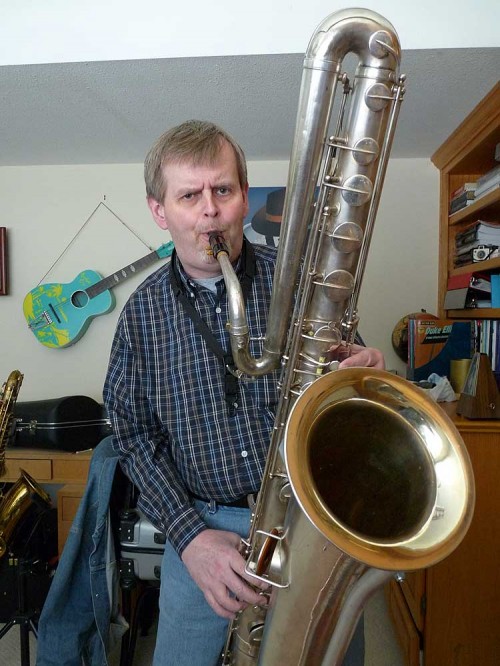Yesterday I got to do something that I enjoy doing very much: sharing my collection of unusual—and in some cases rare—vintage saxophones with a friend and fellow saxophone player. Saxophones are meant to be played, and while a number of mine get played quite a bit, others don’t get out of their cases nearly often enough.
Having another sax player over to play my horns is an enjoyable way to spend the afternoon, because it allows me to let someone who is interested in vintage saxes, try a pretty good sized sampling of some great vintage horns. It is not easy to find this large a variety of vintage saxophones in working condition that you can actually play test.
Personally, I like to do nothing better than to spend hours trying out different brands of vintage saxes. Maybe it’s the teacher in me, but I like to give back for all the hours that others have given to me over the years. That’s why I have always been fairly generous with my time, and with access to my saxophones.
Kevin playing my nickel plated Hammerschmidt Klingsor tenor
A number of weeks ago I had the opportunity to meet Kevin, the fellow who bought the mysterious Lafleur alto that was being sold through a music store Winnipeg. Since we met, Kevin and I have gotten together a number of times, but always at his house. Yesterday was the first time that he had the opportunity to come out to my place, and spend the afternoon in my studio.
Kevin really wanted to try 2 things: my sopranos and my bass. Kevin had always been a tenor player in school, and had never played an alto until he bought the Lafleur. He has really taken to alto, so he was thinking that his next horn choice might be soprano.
Since I have both a vintage Pan American curvy, and a Mark VI, yesterday’s visit gave him the chance to play both types of sopranos for the first time. I must confess, perhaps I didn’t have enough of reed selection for a novice soprano player, but Kevin did not fall in love with this, the smallest horn of the regular saxophone family.
Although Kevin had never played baritone before, he naturally took to my low Bb Mark VI. Within minutes he was playing that horn like he’d played baritone for years. I was starting to think that Kevin was really a large horn player. This suspicion was confirmed when he tried my Buescher bass.
Kevin had never played a bass saxophone before either. I gave him my usual spiel about approaching the bass like it’s its own instrument, not a saxophone. I always tell people, think of it as a horn that shares the same fingerings as a saxophone, but is unique. That’s how you’re going to get it to really sing.
As soon as Kevin was comfortable with the key layout of the Buescher, he started to noodle around. The sound coming from this leaky old bass was astounding. It was melodic, and very pretty. Kevin was a natural bass player, and oh so much a large horn player.
Kevin fell in love with my bass. He said he could have played it for an hour more.
What Kevin’s experience yesterday really shows, is that sometimes we have a preconceived idea of what voice of horn we want to play. However, given the opportunity to try a variety of saxophone voices, our actual personal choice might be very different.
So many students start off in school playing alto saxophone. Sometimes, like in my friend Kevin’s case, a student does start off on tenor. However, other voices of saxophones are not really practical, nor available to beginning students.
If a student does decide to continue with their saxophonic pursuits past their high school career—or picks up the instrument again as an adult—trying to choose what voice of sax speaks for you, might not be an easy task. Issues of access can be a barrier to finding your true saxophonic voice.





